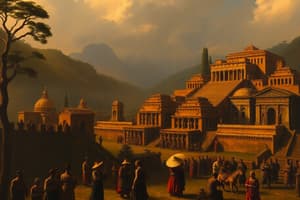Podcast
Questions and Answers
¿Qué figura era conocida como el 'Hijo del Sol' y ejercía el poder máximo en el Tahuantinsuyo?
¿Qué figura era conocida como el 'Hijo del Sol' y ejercía el poder máximo en el Tahuantinsuyo?
- Apu Inka
- Inca (correct)
- Corregidor
- Qarisuyu
¿Cómo se basaba principalmente la economía del Tahuantinsuyo?
¿Cómo se basaba principalmente la economía del Tahuantinsuyo?
- Economía de mercado
- Trueque directo
- Capitalismo de mercado
- Sistema de redistribución (correct)
¿Qué era el 'quipu' en el contexto del imperio incaico?
¿Qué era el 'quipu' en el contexto del imperio incaico?
- Un sistema de cuerdas anudadas para mantener registros económicos (correct)
- Un tipo de moneda
- Una estructura arquitectónica importante
- Una figura religiosa venerada
¿Quiénes encabezaban los senoríos en las provincias del Tahuantinsuyo?
¿Quiénes encabezaban los senoríos en las provincias del Tahuantinsuyo?
¿Cuál era el principal elemento arquitectónico utilizado por el imperio incaico en su infraestructura agraria?
¿Cuál era el principal elemento arquitectónico utilizado por el imperio incaico en su infraestructura agraria?
¿Cuál era el enfoque principal de la cultura del Tahuantinsuyo?
¿Cuál era el enfoque principal de la cultura del Tahuantinsuyo?
¿Qué característica define la arquitectura del Tahuantinsuyo?
¿Qué característica define la arquitectura del Tahuantinsuyo?
¿Cómo se estructuraba la sociedad del Tahuantinsuyo en términos de jerarquía?
¿Cómo se estructuraba la sociedad del Tahuantinsuyo en términos de jerarquía?
¿Qué aspecto destaca en la organización política del Tahuantinsuyo?
¿Qué aspecto destaca en la organización política del Tahuantinsuyo?
¿Qué sobresale en cuanto a economía en el Tahuantinsuyo?
¿Qué sobresale en cuanto a economía en el Tahuantinsuyo?
Flashcards are hidden until you start studying
Study Notes
Exploring the Intriguing Era of the Tahuantinsuyo: A Deep Dive into the Empire's Subtopics
As the Inca Empire, or Tahuantinsuyo, blossomed in the heart of the Peruvian Andes, it left a rich tapestry of history for us to unravel. To better understand the might of this ancient civilization, let's dive into the specifics of its organization, economy, culture, architecture, and society.
Organización política
The Tahuantinsuyo was a highly centralized empire, with a complex and hierarchical political system. The main figure was the Inca, the "Son of the Sun," who ruled over four main regions, or suyus: Chinchaysuyu, Antisuyu, Kollasuyu, and Qarisuyu. Each suyu consisted of smaller provinces, or senoríos, headed by local leaders known as corregidores. These leaders would report to a member of the Inca's immediate family, the Apu Inka, who oversaw the empire's military and political affairs.
Economía
The Tahuantinsuyo's economy was largely based on a system of redistribution, where resources from the provinces were sent to the capital, Cusco. Agriculture played a crucial role, with the empire's agrarian infrastructure thriving on the terraced fields of the Andes. The empire also utilized a system of mit'a, where communities would take turns working on public projects. The empire's economy was rounded out by the introduction of a currency, the quipu, a system of knotted cords used to keep track of economic data.
Cultura
The Tahuantinsuyo's cultural legacy is as rich as its political and economic systems. The empire's art and architecture are celebrated for their intricate detail and precise execution in monumental sites like Machu Picchu or the Chachapoya tombs. The Tahuantinsuyo's culture also included a complex belief system, integrating elements of animism and the worship of the Sun. The Tahuantinsuyo's leaders fostered an environment of unity and tolerance through the celebration of different cultural traditions.
Arquitectura y construcciones
The Tahuantinsuyo's architectural feats remain impressive to this day. The empire's capital, Cusco, was built on a grid pattern, with straight streets and an intricate network of canals. Known for its stonework, the Tahuantinsuyo's architectural achievements can be seen in structures like the Inca Trail, Machu Picchu, and the Sun Temple of Tiwanaku. Their construction techniques, including the use of polished, dry-laid stonework, remain a marvel of ancient engineering.
Sociedad
The Tahuantinsuyo's society was structured around strict hierarchies, with the Inca and his family at the pinnacle of the social order. Below them were the upper classes, who were distinguished by their wealth and lineage. The lower classes, comprising artisans, farmers, and laborers, formed the backbone of the empire's economy. The Tahuantinsuyo's society was characterized by its strong gender roles, with women taking on distinct roles from men in the home and in public life.
Despite the Tahuantinsuyo's fascinating history, its legacy has been shaped by the imperfections of its records and the interpretations of the archeologists and historians who have studied it. As we explore the empire's organization, economy, culture, architecture, and society, we must maintain an open-minded approach to understanding the intricacies of this remarkable civilization.
Studying That Suits You
Use AI to generate personalized quizzes and flashcards to suit your learning preferences.




